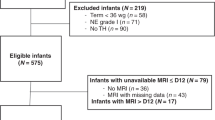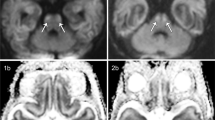Abstract
Hypoxic–ischemic brain damage in preterm and term infants is one major cause of neonatal neurologic morbidity. Depending on the gestational age and the extent of hypoxia, different pathologic findings have been observed. Hypoxic–ischemic lesion of the thalamus is the least common form of cerebral injury. Although long-term outcome with spastic or extrapyramidal cerebral palsy is known, clinical features in the neonatal period are not well described.
We report an infant with bilateral hypoxic–ischemic thalamic lesions after maternal cardiac arrest at 28 weeks of gestation. Clinical features and diagnostic results of our patient are compared to information given in the literature to define the clinical entity of hypoxic–ischemic thalamic lesions in neonates better.
This is a preview of subscription content, access via your institution
Access options
Subscribe to this journal
Receive 12 print issues and online access
$259.00 per year
only $21.58 per issue
Buy this article
- Purchase on Springer Link
- Instant access to full article PDF
Prices may be subject to local taxes which are calculated during checkout
Similar content being viewed by others
References
Volpe JJ Neurology of the newborn Third Edition Philadelphia: WB Saunders 1995 p. 211
Cohen M, Roessmann U In utero brain damage: Relationship of gestational age to pathological consequences Dev Med Child Neurol 1994 36 263–70
De Vries LS, Eken P, Groenendaal F, Rademaker KJ, Hoogervorst B, Bruinse HW Antenatal onset of hemorrhagic and/or ischaemic lesions in preterm infants: prevalence and associated obstetric variables Arch Dis Child Fetal Neonat Ed 1998 78 F51–6
Roland EH, Hill A, Norman MG, Flodmark O, MacNab AJ Selective brainstem injury in an asphyxiated newborn Ann Neurol 1988 23 89–92
Bordarier C, Moktari M, Rodriguez D, Adamsbaum C, Robain O Antenatal thalamic lesions in the newborn: two anatomoclinical cases Brain Dev 1997 19 495–8
Eicke M, Briner J, Willi U, Uehlinger J, Boltshauser E Symmetrical thalamic lesions in infants Arch Dis Child 1992 67 15–9
Parisi JE, Collins GH, Kim RC, Crosley CJ Prenatal symmetrical thalamic degeneration with flexion spasticity at birth Ann Neurol 1983 13 94–7
DiMario F, Clancy R Symmetrical thalamic degeneration with calcifications of infancy Am J Dis Child 1989 143 1056–60
Roland EH, Poskitt K, Rodriguez E, Lupton BA, Hill A Perinatal hypoxic–ischemic thalamic injury: clinical features and neuroimaging Ann Neurol 1998 44 161–6
Natsume J, Watanabe K, Kuno K, Hayakawa F, Hashizume Y Clinical, neurophysiologic, and neuropathological features of an infant with brain damage of total asphyxia type (Myers) Pediatr Neurol 1995 13 61–4
Trounce JQ, Fawer CL, Punt J, Dodd KL, Fielder AR, Levene MI Primary thalamic haemorrhage in the newborn: a new clinical entity Lancet 1985 Jan 26 190–2
Donn SM Possible mechanisms of primary thalamic haemorrhage in newborn Lancet 1985 Apr 6 823
Kyllerman M, Bager B, Bensch J, Bille B, Olow I, Voss H Dyskinetic cerebral palsy: I. Clinical categories, associated neurological abnormalities and incidences Acta Paediatr Scand 1982 71 543–50
Okumura A, Hayakawa F, Kato T, Kuno K, Watanabe K Bilateral basal ganglia–thalamic lesions subsequent to prolonged fetal bradycardia Early Hum Dev 2000 58 (2) 111–8
Acknowledgements
The authors thank both K. Drews, MD, Department of Radiology, University of Tuebingen, and M. Bitzer, MD, Department of Neuroradiology, University of Tuebingen, for performing the excellent ultrasound scans and neuroimaging studies on our patient and for their advice in selecting the adequate images.
Author information
Authors and Affiliations
Rights and permissions
About this article
Cite this article
Banerjea, M., Speer, C. Bilateral Thalamic Lesions in a Newborn with Intrauterine Asphyxia After Maternal Cardiac Arrest — a Case Report with Literature Review. J Perinatol 21, 405–409 (2001). https://doi.org/10.1038/sj.jp.7210560
Published:
Issue Date:
DOI: https://doi.org/10.1038/sj.jp.7210560



